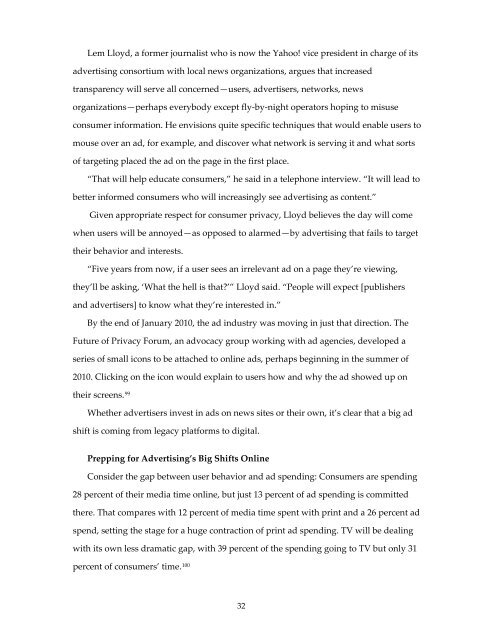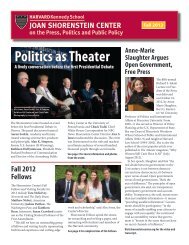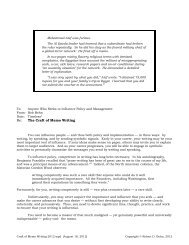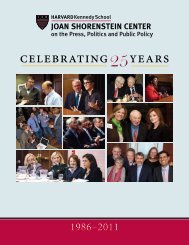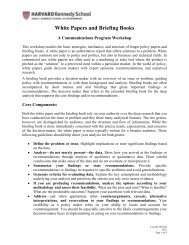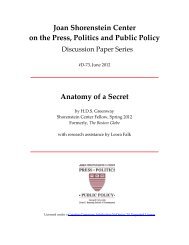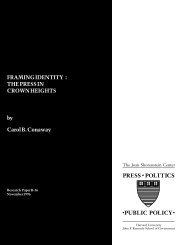A User-First Framework for Sustaining Local News - Harvard ...
A User-First Framework for Sustaining Local News - Harvard ...
A User-First Framework for Sustaining Local News - Harvard ...
Create successful ePaper yourself
Turn your PDF publications into a flip-book with our unique Google optimized e-Paper software.
Lem Lloyd, a <strong>for</strong>mer journalist who is now the Yahoo! vice president in charge of its<br />
advertising consortium with local news organizations, argues that increased<br />
transparency will serve all concerned—users, advertisers, networks, news<br />
organizations—perhaps everybody except fly‐by‐night operators hoping to misuse<br />
consumer in<strong>for</strong>mation. He envisions quite specific techniques that would enable users to<br />
mouse over an ad, <strong>for</strong> example, and discover what network is serving it and what sorts<br />
of targeting placed the ad on the page in the first place.<br />
“That will help educate consumers,” he said in a telephone interview. “It will lead to<br />
better in<strong>for</strong>med consumers who will increasingly see advertising as content.”<br />
Given appropriate respect <strong>for</strong> consumer privacy, Lloyd believes the day will come<br />
when users will be annoyed—as opposed to alarmed—by advertising that fails to target<br />
their behavior and interests.<br />
“Five years from now, if a user sees an irrelevant ad on a page they’re viewing,<br />
they’ll be asking, ‘What the hell is that?’” Lloyd said. “People will expect [publishers<br />
and advertisers] to know what they’re interested in.”<br />
By the end of January 2010, the ad industry was moving in just that direction. The<br />
Future of Privacy Forum, an advocacy group working with ad agencies, developed a<br />
series of small icons to be attached to online ads, perhaps beginning in the summer of<br />
2010. Clicking on the icon would explain to users how and why the ad showed up on<br />
their screens. 99<br />
Whether advertisers invest in ads on news sites or their own, it’s clear that a big ad<br />
shift is coming from legacy plat<strong>for</strong>ms to digital.<br />
Prepping <strong>for</strong> Advertising’s Big Shifts Online<br />
Consider the gap between user behavior and ad spending: Consumers are spending<br />
28 percent of their media time online, but just 13 percent of ad spending is committed<br />
there. That compares with 12 percent of media time spent with print and a 26 percent ad<br />
spend, setting the stage <strong>for</strong> a huge contraction of print ad spending. TV will be dealing<br />
with its own less dramatic gap, with 39 percent of the spending going to TV but only 31<br />
percent of consumers’ time. 100<br />
32


